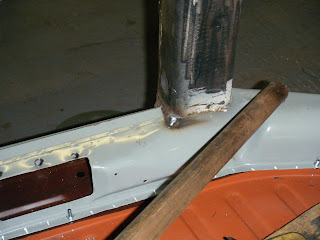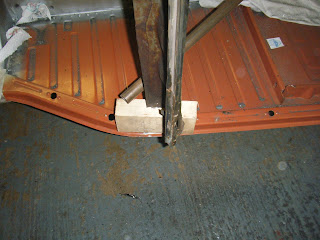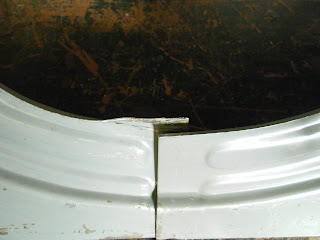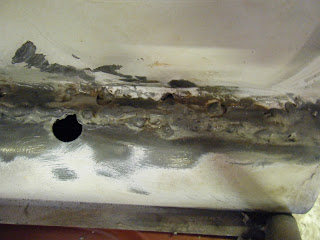I had a bit of time off work so dedicated it to trying to make some progress. Here's how I did...
First I bolted a heater channel closing panel in place. This panel is being used as a dummy for the purpose of getting things together. I'm not over keen on the quality so will likely buy better before final welding.
Next the rear cross member was bolted in. At this stage I'm not sure whether the channel closing panel should sit on top of, or underneath the cross member but will find out before I get to the point where I can't change it.
Here I have the first of the genuine heater channels. The spot welds holding the heater pipe were drilled and the pipe removed as I have a plan that I would like to try if I am able (more as and when I get to that point). I'm not running any heating anyway so I don't cause a problem for myself in doing this at this point. It also gives me a slight weight loss advantage.
With the channel in place I found a conflict at the rear where the earlier quarter panel repairs had been done. This area was cut away to enable the rear quarter to sit on the channel properly.
Here is the channel in place. Note the rear cross member and front bulkhead panels located to ensure correct alignment of the heater channel.
Next task was to secure the heater channel to the closing panel and so install some of the missing rigidity. This was first done by drilling both panels and using cleco pins set every six inches.
Most of the pins were then replaced with 4mm set screws as I wanted to ensure the arrangement was as rigid as possible whilst carrying out the rest of the body panel repairs. The rear quarter was then tack welded in a couple of places to stop the body falling off.
The door gap was roughly set and the A pillar tacked into position. As repairs will be carried out on both A pillar and Rear quarter, fine adjustments will be made then.
This is the build of my replacement race car. I crashed in the original car after a blown rear tyre and just two (and a half!) runs in it. I hope to update weekly even if I've only made a small amount of progress. Drop back and see how it's going.
Monday, 12 November 2012
Tuesday, 30 October 2012
Strengthening the body...or not (quite yet)
Now the body is on the chassis I want to get some strength back in it.
With no front clip or rear cross members the body is free to move around once the bracing I added is removed. Unfortunately I've found I can't fit the new rear cross members due to the repairs that had previously been done to the heater channels. I've also noticed that all the weight of the body is on the outside edge of the pan halves, pulling them downwards slightly.
All of this needs needs sorting out before anything is finally welded into place, and after a lot of thinking if decided that, to move forwards, I needs to go backwards slightly. The only way I can get the new rear cross members in place, and also take the load off the pan edges is to start by replacing the heater channels. I didn't want to take more strength out of the body at this stage but it seems to be the only way forwards. So I will remove and replace each heater channel, tacking them to the body and bolting them to the pan. This will add the strength and allow fitting of the rear cross members before I then tackle the rear quarter repairs...or at least that's the theory.
Door removed so I can see what I'm up against.
Heater channel opened up. Note the rust already taking hold inside the "new" pattern heater channel.
Front end opened up...
...and the centre section removed.
Using an angle grinder with a cutting disc the rest of the heater chanel was removed and wood blocks used to support the body. I'm glad I took this step as it confirms the previous repairs were not to the standard I want.
With no front clip or rear cross members the body is free to move around once the bracing I added is removed. Unfortunately I've found I can't fit the new rear cross members due to the repairs that had previously been done to the heater channels. I've also noticed that all the weight of the body is on the outside edge of the pan halves, pulling them downwards slightly.
All of this needs needs sorting out before anything is finally welded into place, and after a lot of thinking if decided that, to move forwards, I needs to go backwards slightly. The only way I can get the new rear cross members in place, and also take the load off the pan edges is to start by replacing the heater channels. I didn't want to take more strength out of the body at this stage but it seems to be the only way forwards. So I will remove and replace each heater channel, tacking them to the body and bolting them to the pan. This will add the strength and allow fitting of the rear cross members before I then tackle the rear quarter repairs...or at least that's the theory.
Door removed so I can see what I'm up against.
Heater channel opened up. Note the rust already taking hold inside the "new" pattern heater channel.
Front end opened up...
...and the centre section removed.
Using an angle grinder with a cutting disc the rest of the heater chanel was removed and wood blocks used to support the body. I'm glad I took this step as it confirms the previous repairs were not to the standard I want.
Sunday, 14 October 2012
At last!
After work, the house and a few other things taking priority I finally managed some time on the car today. Out came the and grinder and I finished separating the second inner rear quarter panel.
Sunday, 7 October 2012
Still no progress!
I've been in Portugal & Spain all week, which was planned. What wasn't planned was a minor disaster with the hot water boiler in the house!
Woke up to a cold house and a damp ceiling so had to get the leak sorted and the hot water back on. Wouldn't have minded if it was an old boiler but we only had it fitted 6 months ago. We've got a temporary repair done and an engineer coming some time tomorrow to fix it properly.
Woke up to a cold house and a damp ceiling so had to get the leak sorted and the hot water back on. Wouldn't have minded if it was an old boiler but we only had it fitted 6 months ago. We've got a temporary repair done and an engineer coming some time tomorrow to fix it properly.
Sunday, 30 September 2012
Sorry, nothing done this week...
...unfortunately work on the house took priority this week so nothing done on the car. Hopefully back at it next week!
Sunday, 23 September 2012
Bit more done....
...but no pictures today as drilling more spot welds isn't the most fantastic photo subject!
Today I set to work on the second used rear quarter, that I bought, to separate the inner panel. Lots of scraping of seam sealer followed by drilling of spot welds. Got a couple of hours in but didn't manage to complete it.
Today I set to work on the second used rear quarter, that I bought, to separate the inner panel. Lots of scraping of seam sealer followed by drilling of spot welds. Got a couple of hours in but didn't manage to complete it.
Monday, 17 September 2012
Inner rear quarters
With the previous repairs to the inner rear quarters not being to the standard I want, I went on the search for a pair of good panels from a scrapped car. Luckily I turned up a pair not too far away so went and collected them.
Here we have the left side. The outers had been patched in the past but the inners were excellent and unrepaired.
So I cracked out the drill and angle grinder and got on with removing the spot welds. After some considerable time I was left with this which I don't need...
...and this, one of the panels I needed.
Here we have the left side. The outers had been patched in the past but the inners were excellent and unrepaired.
So I cracked out the drill and angle grinder and got on with removing the spot welds. After some considerable time I was left with this which I don't need...
...and this, one of the panels I needed.
Monday, 10 September 2012
Which rear cross members?
The first set were sold by a well known UK seller as being genuine VW but when received were found to be Klockerholm parts (the sticker on them gave this away!). When queried with the seller they stated that Klockerholm was an OE supplier to VW. The pressings were far from good with heavy rippling on the largest flat face. The holes that the bolts go through into the floorpan were also not punched in.
I then looked for a better pair and, when Heritage linked in to supply VW Classic parts I thought my luck was in. Having ordered both sides again I received one grey and one black cross member (Mexican and Brazilian I guess). The grey part was excellent quality but the black one not. When compared to the Klockerholm parts I already had the black "OE VW" part looked very similar if not identical so I do now believe what I was told by the original supplier of the Klockerholm panels. Unfortunately the area where both cross members join was very different between the genuine black cross member and the grey one so they could not be used as a pair.
My final attempt was a web site purchase from someone who had bought a pair of cross members but not used them. I was informed they were "grey" ones so went ahead and waited for the delivery. On receipt I identified them as the grey, pattern type that Heritage used to sell and that were credited with good reviews by people who had used them when available.
So, given the Klockerholm are not the quality I'm looking for (worst quality in my opinion), and I only have one genuine grey cross member (best quality in my opinion and, if I had a pair these are the ones I'd be using), I've decided to use the two grey pattern parts (they need a bit of work to make them fit together but overall the pressings are quite OK).
Below are the six I had to choose from.
Here is the problem area on the grey pattern parts.
Reworking the problem area.
...and here it is finished.
Monday, 3 September 2012
...and the other side
Much the same this side although it does look like there has been no repair patch made this time.
On the negative side it appears the inner panel has been cut accidentally at the B pillar side when cutting the old outer rear quarter out during a previous repair. An attempt has been made to weld the damage.
Now I know what I have on both sides I'm deciding how to tackle the repairs and how much metal to replace.
On the negative side it appears the inner panel has been cut accidentally at the B pillar side when cutting the old outer rear quarter out during a previous repair. An attempt has been made to weld the damage.
Now I know what I have on both sides I'm deciding how to tackle the repairs and how much metal to replace.
Monday, 27 August 2012
What lies beneath?
There is a lot of filler in the body and, given the quality of welding I can see, I want to know what is underneath it all, so this is the start of removing it, assessing what repairs have been done before and completing repairs to the standard I want. I also want to put some strength back in the body as soon as possible. With both these thoughts in mind I'm starting at the rear. I'll put in some rear cross members (currently missing) but before doing this I need to look at what is underneath the filler and seam sealer shown below.
First bit of poor repair found.
The rest of the repair doesn't look too bad but does look like a home made repair panel on this side so I'll replace this with OE metal.
Most of what is covering the repair here is seam sealer so its a bit tricky to remove. I resorted to using an old wood chisel to "cut" it off and then removed the remainder with a wire brush on the angle grinder (this tended to melt the remnants rather than actually brush it away).
First bit of poor repair found.
The rest of the repair doesn't look too bad but does look like a home made repair panel on this side so I'll replace this with OE metal.
Monday, 20 August 2012
Aligning the body
As mentioned last time the body would not sit correctly on the 'pan. This was because the pattern heater channels were fouling the seat runners as can be seen in the next two pictures.
Here you can see the extent of the problem this was causing. The body need to sit flush with the rear edge of the 'pan so that the mounting bolts can be fitted.
As I will not be using these heater channels the simplest solution was to trim the offending material away.
Final position of the body is shown below and enabled all the mounting bolts to be fitted and tightened.
Shot showing the body bolted in position and also some of the bracing I used before removing the body from the original 'pan. It's just some steel tube I had lying around welded in diagonally and triangulated to put some strength back. I'd also left it in place during transportation to the new house and whilst lifting the body onto the new 'pan, as the body has so much material removed it had become extremely flexible.
Here you can see the extent of the problem this was causing. The body need to sit flush with the rear edge of the 'pan so that the mounting bolts can be fitted.
As I will not be using these heater channels the simplest solution was to trim the offending material away.
Final position of the body is shown below and enabled all the mounting bolts to be fitted and tightened.
Shot showing the body bolted in position and also some of the bracing I used before removing the body from the original 'pan. It's just some steel tube I had lying around welded in diagonally and triangulated to put some strength back. I'd also left it in place during transportation to the new house and whilst lifting the body onto the new 'pan, as the body has so much material removed it had become extremely flexible.
Sunday, 12 August 2012
Body on 'pan
I've been out and about collecting parts so not so much time in the garage. That said, again with the help of my poor wife, we managed to get the body onto the 'pan.
It wasn't quite positioned correctly (a bit too far forwards) and was being prevented from going into the right place by the pattern heater channels hitting the seat runners. This would need sorting out first and before the body could be bolted down and work started.
It wasn't quite positioned correctly (a bit too far forwards) and was being prevented from going into the right place by the pattern heater channels hitting the seat runners. This would need sorting out first and before the body could be bolted down and work started.
Sunday, 5 August 2012
Tidy up time
With the floorpan ready it was time for a bit of a tidy up in the garage. For the first time since we moved into the house and put the chassis spine in the garage, the garage door was opened. With the help of my wife the 'pan was moved out, the floor tidied up, the 'pan flipped right way up and then put back in but this time with the front end facing to the door. I also took the opportunity to move my trailer over a bit to give me slightly more space to work on the car which will only get wider as time progresses.
Here is what will be going on the 'pan. It looks quite good from the picture but needs a lot of work and I'll also be putting back a lot of the steel that was removed when it was cut to lighten it for racing. As I bought it like this (minus these doors which I bought new and cut the window frames myself) I want to see exactly what I've got before starting, so I'll be removing all the filler to check the welding quality and previous repairs. The welding I can see is not to the standard I want so I expect to be doing quite a bit of work here.
Here is what will be going on the 'pan. It looks quite good from the picture but needs a lot of work and I'll also be putting back a lot of the steel that was removed when it was cut to lighten it for racing. As I bought it like this (minus these doors which I bought new and cut the window frames myself) I want to see exactly what I've got before starting, so I'll be removing all the filler to check the welding quality and previous repairs. The welding I can see is not to the standard I want so I expect to be doing quite a bit of work here.
Sunday, 29 July 2012
Finishing up the floorpan
This week I'm finally finishing up the structural floorpan work.
First thing to do was to weld up the holes used for the Cleco pins. As these holes were also to be used as plug welds to hold the pan halves in place they were first drilled out to increase their diameter.
This handy tool is a copper sheet with magnets in each corner. It's used to place behind open holes when welding. The idea is that the sheet gives the molten welding material something to lay against and, being copper, the weld does not stick to it.
With the pan the right way up and the mig out I took the opportunity to weld up the holes in the framehorns, left when I removed the heater control conduits.
Plug welding the holes using the copper sheet in place underneath.
The pan was then flipped over to finish the welds on the underside nicely.
Here you can see a hole in the chassis spine that I'd not yetwelded up. Visible through the hole is the copper sheet prior to welding.
Welds underneath completed.
Last bit of welding was the rear of the pan halves to the torsion tube housing.
All welding completed, welds cleaned up and primed.
First thing to do was to weld up the holes used for the Cleco pins. As these holes were also to be used as plug welds to hold the pan halves in place they were first drilled out to increase their diameter.
This handy tool is a copper sheet with magnets in each corner. It's used to place behind open holes when welding. The idea is that the sheet gives the molten welding material something to lay against and, being copper, the weld does not stick to it.
With the pan the right way up and the mig out I took the opportunity to weld up the holes in the framehorns, left when I removed the heater control conduits.
Plug welding the holes using the copper sheet in place underneath.
The pan was then flipped over to finish the welds on the underside nicely.
Here you can see a hole in the chassis spine that I'd not yetwelded up. Visible through the hole is the copper sheet prior to welding.
Welds underneath completed.
Last bit of welding was the rear of the pan halves to the torsion tube housing.
All welding completed, welds cleaned up and primed.
Subscribe to:
Comments (Atom)























































